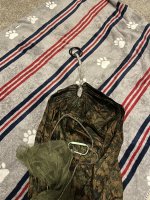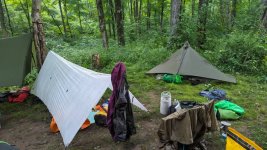When a fellow wilderness guide instructor convinced me to try hammock camping, I can tell you it was a frustrating couple of nights until I learned some valuable lessons. I knew I needed a Thermarest pad inside under me, even on relatively warm summer nights. The dang thing kept floating up and ending up on top of me. So very frustrating. I soon decided to take an old bed sheet, sew it to make a bag out of it and place my pad and sleeping bag inside. Problem solved. Later I bought Big Agnes bags with built in bottom sleeves to hold a pad. Problem solved again. How tight and at what level to tie the ends between trees is a very trial and error personal learning process to find the right level so you don't slide down where you don't want to be in the thing.
After we convinced other instructors to try their first night in a hammock, it became a comedy show to watch their antics until they learned too. Most became converts like me. Especially those of us who like to primitive camp away from designated flat treeless campsites and prefer to be in rough unlevel terrain at random lake shore sites, or when bushwhacking between remote ponds. A second extra lightweight large silnylon tarp over the integral netting and tarp completes adequate rough storm proofing gear. I feel that necessary extra weight and bulk to survive in very cold 4th season weather means you might as well just use an old school lightweight tent for better comfort.
After we convinced other instructors to try their first night in a hammock, it became a comedy show to watch their antics until they learned too. Most became converts like me. Especially those of us who like to primitive camp away from designated flat treeless campsites and prefer to be in rough unlevel terrain at random lake shore sites, or when bushwhacking between remote ponds. A second extra lightweight large silnylon tarp over the integral netting and tarp completes adequate rough storm proofing gear. I feel that necessary extra weight and bulk to survive in very cold 4th season weather means you might as well just use an old school lightweight tent for better comfort.



